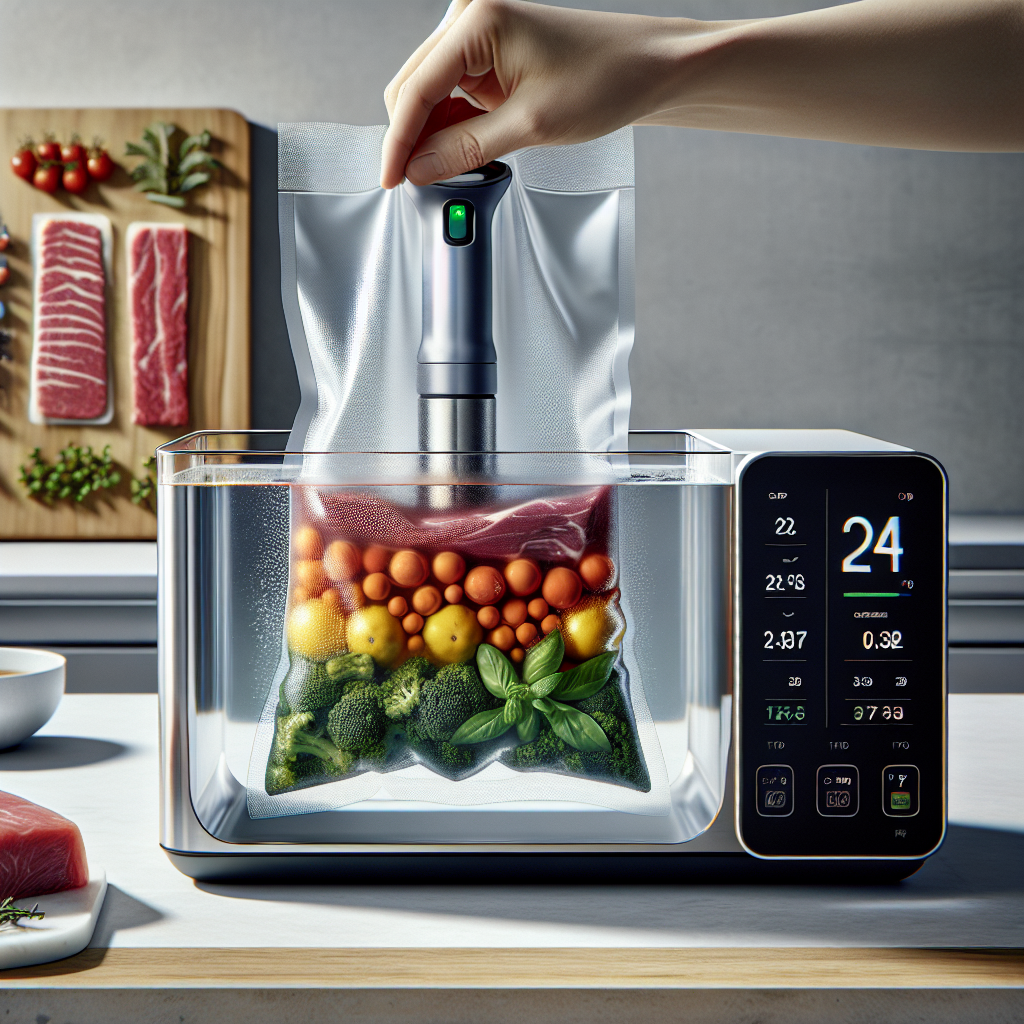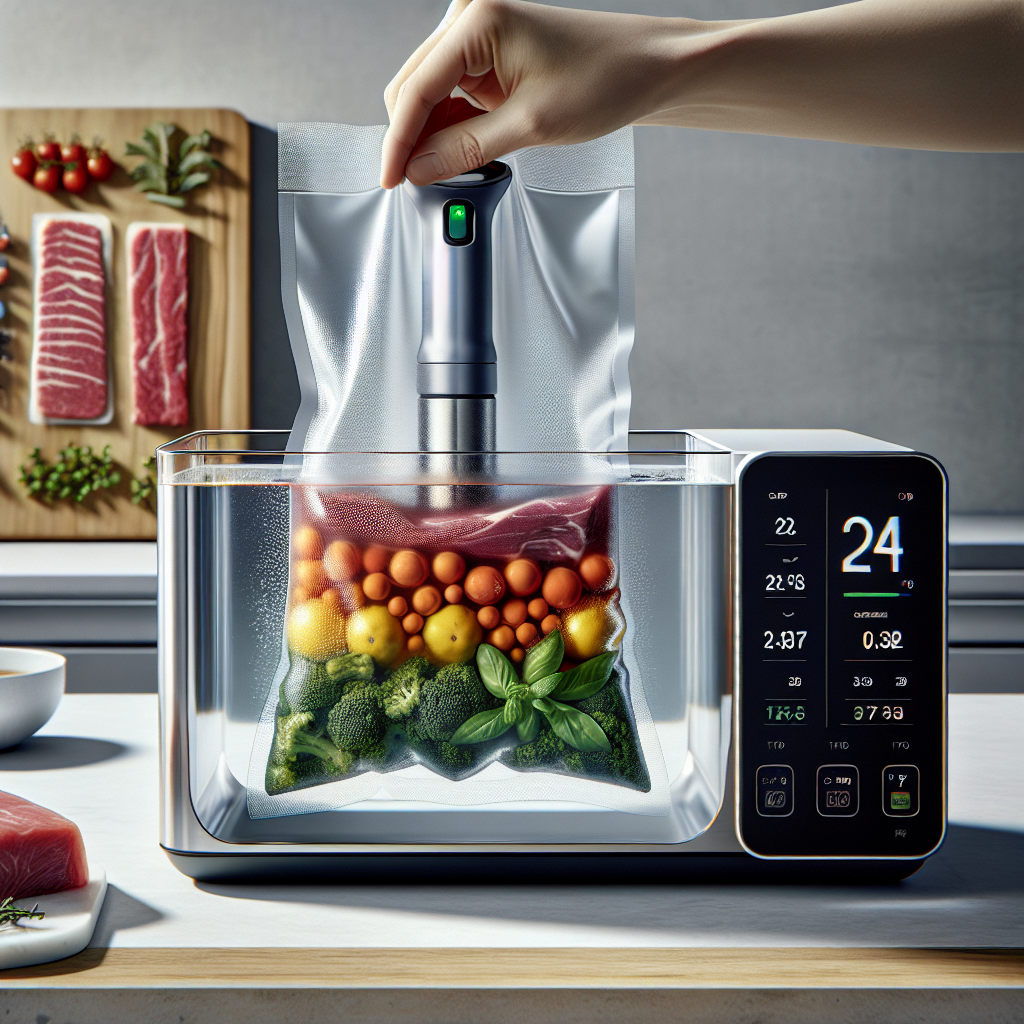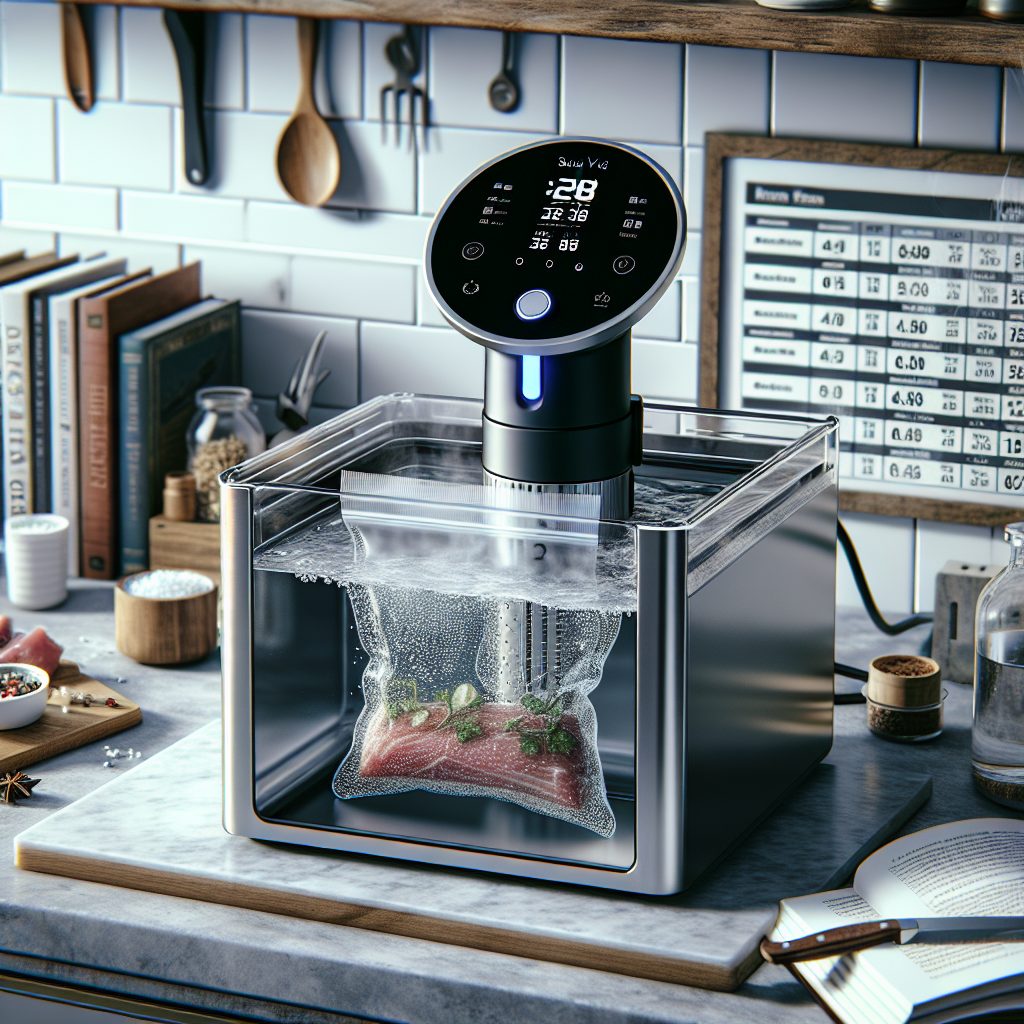
So you’ve heard about the wonders of sous vide cooking and are eager to try it out for yourself. But you can’t help but wonder, is it possible to overcook food with this innovative cooking method? Well, let’s put your mind at ease. In this article, we will delve into the world of sous vide cooking and explore whether or not it is possible to overcook your food using this technique. Get ready to discover the secrets of perfectly cooked sous vide meals that will have your taste buds dancing with delight.
Understanding Sous Vide Cooking
What is sous vide?
Sous vide, which translates to “under vacuum” in French, is a cooking technique that involves sealing food in a vacuum-sealed bag and cooking it in a precisely controlled water bath. This method ensures that the food is cooked evenly throughout and retains its moisture, resulting in tender and flavorful dishes.
How does sous vide work?
Sous vide cooking relies on the principle of precision temperature control. By immersing the vacuum-sealed food in a water bath set at a specific temperature, it allows for slow and gentle cooking. The water circulates around the food, ensuring an even distribution of heat and consistent cooking. This method eliminates the risk of overcooking as the food can never exceed the water bath’s temperature.
Advantages of sous vide cooking
Sous vide cooking offers numerous advantages that make it a popular technique among both home cooks and professional chefs. One significant advantage is the precise control it provides over the cooking temperature, resulting in consistent and repeatable results. Additionally, sous vide cooking allows for the retention of juices and flavors that can be lost through traditional cooking methods. It also gives the flexibility to cook large quantities of food in advance and store them without compromising their quality.
Controlled temperature and cooking time
One of the key elements of sous vide cooking is the ability to control both the temperature and cooking time with great accuracy. The water bath can be set to the desired cooking temperature, which remains constant throughout the cooking process. This controlled environment ensures that the food is cooked to perfection without the risk of undercooking or overcooking. By adjusting the cooking time, chefs can achieve different levels of doneness, offering versatility and control over the final result.
Effects of Overcooking
Why is overcooking undesirable?
Overcooking can have detrimental effects on the taste, texture, and overall quality of the food. When food is subjected to high temperatures for an extended period, it can become dry, tough, and lose its natural flavors. Overcooked proteins can turn rubbery and dry, while vegetables can become mushy and lose their vibrant color.
Changes in texture
One of the noticeable effects of overcooking is the alteration of the food’s texture. Meats that are overcooked can lose their tenderness, becoming stringy and difficult to chew. Vegetables can become soft and lose their natural crunch, resulting in an unappetizing texture. Texture plays a crucial role in the enjoyment of food, and overcooking can significantly impact the overall dining experience.
Loss of flavor and juiciness
Overcooking can lead to a loss of flavor and juiciness in food. As proteins are cooked for an extended period, their natural juices are expelled, leaving them dry and lacking in flavor. This can be especially noticeable in leaner cuts of meat. Vegetables, which contain delicate compounds responsible for their taste, can lose their distinct flavors when overcooked. The juiciness and flavors of the food are best preserved through precise temperature control, a key feature of sous vide cooking.
Potential health risks
Overcooking food can also pose potential health risks. When food is subjected to high temperatures for too long, harmful compounds can form. For example, when proteins are overcooked, they can create harmful substances called heterocyclic amines (HCAs) and polycyclic aromatic hydrocarbons (PAHs). These compounds have been linked to an increased risk of cancer. Sous vide cooking, with its precise temperature control, minimizes the risk of creating these harmful compounds, ensuring the safety of the food.

Factors Influencing Overcooking
Cooking temperature
The cooking temperature plays a critical role in preventing overcooking. When the temperature is too high, the food can quickly go from perfectly cooked to overcooked. It is important to use a sous vide machine that allows precise temperature control to avoid exceeding the desired level of doneness.
Cooking time
The duration of cooking also affects the risk of overcooking. Longer cooking times can lead to the gradual breakdown of proteins and loss of moisture, resulting in an undesirable texture and taste. Monitoring and adjusting the cooking time according to the specific food being cooked is crucial to achieve optimal results.
Thickness and type of food
The thickness and type of food being prepared are important factors in determining the cooking time and temperature required. Thicker cuts of meat or dense vegetables require more time to cook thoroughly, while delicate items like fish or tender vegetables may require significantly less cooking time. Understanding the characteristics of different foods and their cooking requirements is essential in avoiding overcooking.
Insulation and water circulation
The efficiency of insulation and water circulation in the sous vide cooking setup can impact the cooking process. Without proper insulation, heat loss can occur, leading to prolonged cooking times and potential overcooking. Maintaining sufficient water circulation around the food ensures even cooking and minimizes the risk of hot spots that can cause overcooking in localized areas.
Temperature Control in Sous Vide
Precision of temperature control
Sous vide cooking is renowned for its precise temperature control, allowing for consistent results. With a high-quality sous vide machine, you can set the desired temperature to a fraction of a degree and trust that it will remain constant throughout the cooking process. This precision ensures that the food is cooked precisely to the desired level of doneness, eliminating the risk of overcooking.
Maintaining consistent temperature
Maintaining a consistent temperature is crucial in sous vide cooking to prevent overcooking. The sous vide machine uses a heating element and thermostat to monitor and adjust the water bath’s temperature, ensuring it remains constant. The precise control offered by sous vide cooking makes it possible to achieve perfectly cooked food consistently.
Effect of temperature on cooking results
The temperature used in sous vide cooking directly affects the cooking time and the outcome of the final dish. Lower temperatures result in more tender and delicate textures, while higher temperatures can create a firmer and more well-done result. By adjusting the cooking temperature, chefs can customize the doneness of the food to suit their preferences and achieve optimal results without overcooking.
Cooking Time Considerations
Impact of cooking time on food doneness
Cooking time plays a vital role in sous vide cooking, determining the doneness of the food. Longer cooking times allow for more tender and flavorful results, particularly with tougher cuts of meat. However, it is crucial to avoid overcooking by monitoring the cooking time carefully. Each type of food requires a different cooking time, and experimentation and experience are key to finding the ideal balance between time and doneness.
Effects of extended cooking times
Extended cooking times can be both beneficial and detrimental, depending on the type of food being cooked. Some tougher cuts of meat can greatly benefit from longer cooking times as they allow for the breakdown of collagen, resulting in a more tender texture. However, overextended cooking times can lead to a loss of moisture and overcooked, mushy textures. Finding the sweet spot for each food item is essential in achieving the desired level of doneness without sacrificing quality.
Determining optimal cooking time
The optimal cooking time varies depending on factors such as the type of food, desired level of doneness, and personal preferences. It is recommended to start with established sous vide recipes or guidelines for the specific food you are cooking and then adjust and experiment to find the ideal cooking time that suits your taste. Keeping track of the cooking time and making note of the results can help refine your technique and achieve consistently well-executed dishes.
Food Thickness and Type
Importance of food thickness
Food thickness plays a crucial role in sous vide cooking as it directly influences the cooking time required. Thicker foods require more time for the heat to penetrate and cook the center thoroughly. It is important to consider the thickness of the food when determining the cooking time and temperature to ensure that it is cooked evenly throughout without overcooking the exterior.
Adjusting cooking time based on thickness
To achieve perfectly cooked results, it is essential to adjust the cooking time based on the thickness of the food. If a food item is thicker than what the recipe suggests, it will require a longer cooking time. Conversely, if the food is thinner, the cooking time may need to be reduced to prevent overcooking. Adapting the cooking time to the food’s thickness is a key factor in achieving consistent results with sous vide cooking.
Suitability of different food types for sous vide
Sous vide cooking is incredibly versatile and suitable for a wide range of food types. It is particularly well-suited for proteins such as beef, pork, poultry, and seafood, allowing for precise control over their doneness. Additionally, sous vide cooking can enhance the flavors and textures of vegetables, allowing them to retain their vibrant colors and firmness. Fruits, eggs, and even desserts can also benefit from the gentle and precise cooking environment provided by sous vide.
Avoiding Overcooking with Sous Vide
Using precise temperature and time settings
To avoid overcooking, it is paramount to set precise temperature and time settings when using sous vide. Referencing trusted recipes or reputable sources that provide recommended temperatures and cooking times for different foods is a good starting point. Experimentation can then be done to fine-tune the settings according to personal preferences. By utilizing the precise temperature control offered by sous vide cooking, you can achieve consistently well-cooked results without the risk of overcooking.
Monitoring cooking progress
Keeping a close eye on the cooking progress is essential in preventing overcooking. Regularly checking the food’s appearance, texture, and internal temperature can help determine when it reaches the desired level of doneness. This visual and tactile observation allows you to adjust the cooking time if needed and ensures that the food is not left in the water bath for longer than necessary.
Stopping cooking at the right time
Knowing when to stop the cooking process is crucial in sous vide cooking to avoid overcooking. Unlike traditional cooking methods, where the food continues to cook after being removed from the heat source, sous vide cooking stops as soon as the food is taken out of the water bath. By removing the food promptly, you prevent any further heat transfer and ensure that the food retains its desired texture and doneness.
Post-cooking techniques
Certain post-cooking techniques can be employed to enhance the flavors and appearance of the food while reducing the risk of overcooking. For meats, a quick sear in a hot pan or grill can add a desirable crust without overcooking the interior. Similarly, vegetables can be briefly sautéed or roasted to add color and texture. These post-cooking techniques should be used sparingly to avoid undoing the benefits of sous vide cooking and inadvertently overcooking the food.
Common Mistakes in Sous Vide
Underestimating the impact of cooking time
One common mistake in sous vide cooking is underestimating the impact of cooking time. While precise temperature control is a hallmark of sous vide, the cooking time is equally important in achieving optimal results. Failing to adjust the cooking time based on the thickness and type of food can result in undercooked or overcooked dishes. It is essential to consider both temperature and time as critical factors to avoid overcooking with sous vide.
Not adapting to food thickness
Another mistake is neglecting to adapt the cooking time and temperature to the thickness of the food. Thicker foods require longer cooking times to ensure they are cooked evenly throughout. Neglecting to adjust the cooking time can result in undercooked centers or overcooked exteriors. It is crucial to take into account the thickness of the food and adjust the cooking parameters accordingly to prevent overcooking.
Neglecting to monitor the cooking process
Failure to monitor the cooking process is a common pitfall in sous vide cooking. While the precise temperature control provided by sous vide machines reduces the risk of overcooking, it is still important to stay vigilant and regularly check the progress of the food. Visual observation and using a food thermometer can help determine the doneness and prevent overcooking.
Lack of post-cooking steps
Neglecting post-cooking steps can also lead to overcooking. It is common for individuals to overlook the impact of residual heat and continuing cooking even after removing the food from the water bath. Without properly adjusting the cooking time, the food may continue to cook and become overdone. Implementing appropriate post-cooking techniques, such as searing or chilling, is essential in preserving the desired level of doneness.

Benefits of Sous Vide
Consistent and predictable results
One of the key benefits of sous vide cooking is the ability to achieve consistent and predictable results. By precisely controlling the temperature and cooking time, you can replicate successful recipes with accuracy. This consistency is especially valuable for professional chefs and anyone who seeks reliable outcomes in their culinary endeavors.
Enhanced flavors and textures
Sous vide cooking enhances the flavors and textures of the food. By sealing the food in a vacuum-sealed bag, all the juices and flavors are retained, resulting in intensely delicious dishes. The gentle and precise cooking process ensures that the food retains its natural tenderness and juiciness, creating a delightful dining experience.
Reduced risk of overcooking
Sous vide cooking significantly reduces the risk of overcooking. The precise temperature control eliminates the possibility of exceeding the desired level of doneness, resulting in perfectly cooked food every time. With sous vide, the fear of overcooking is greatly diminished, giving you the confidence to cook a wide variety of foods to perfection.
Ability to multitask
Another advantage of sous vide cooking is the ability to multitask. Once the food is sealed in the bag and placed in the water bath, you can walk away and attend to other tasks. Unlike traditional cooking methods that require active monitoring and stirring, sous vide allows you to set the temperature and cooking time and focus on other preparations. This convenience makes it a popular technique for busy individuals who want to enjoy delicious meals without the hassle of constant supervision.
Final Thoughts
Sous vide as a precise cooking method
Sous vide cooking offers a precise and reliable method to achieve consistently well-cooked food. With its precise temperature control, sous vide allows for predictable outcomes and eliminates the risk of overcooking. Whether you are a professional chef or a home cook, sous vide provides a convenient and efficient way to achieve optimal results with minimal effort.
Mastering the art of sous vide
Mastering the art of sous vide involves understanding the importance of temperature control, cooking time adjustments, and considering the thickness and type of food. By carefully honing your sous vide skills and experimenting with different recipes and techniques, you can unlock the full potential of this cooking method and enjoy perfectly cooked meals every time.
Enjoying perfectly cooked food
With sous vide, you can savor the pleasure of perfectly cooked food. The precise control over temperature and time allows you to achieve your desired level of doneness and preserve the food’s natural flavors and juiciness. Whether it’s a tender steak, delicate fish, or vibrant vegetables, sous vide cooking opens up a world of possibilities for creating restaurant-quality meals in the comfort of your own kitchen. So dive into the world of sous vide and elevate your culinary experiences to new heights.





